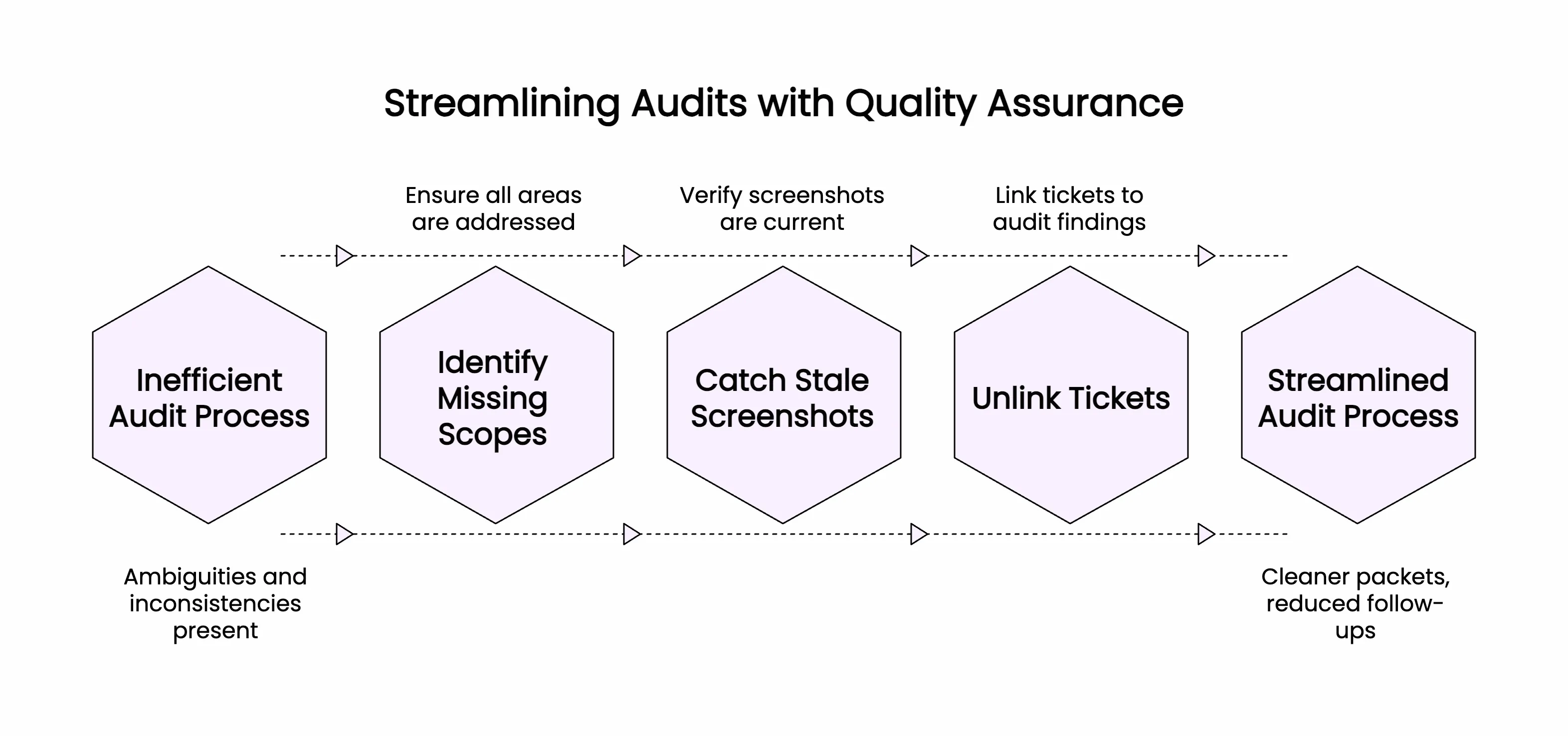Self Service QA for Auditors
Give auditors clean, complete, time-scoped evidence without endless back and forth. Trustero AI for GRC lets QA auditors verify artifacts up front, cut follow-ups, and publish auditor-ready packets.
A QA auditor verifies that control evidence is complete, accurate, and time-scoped before an external audit, using standardized checklists and system integrations to reduce exceptions across SOC 2, ISO 27001, HIPAA, PCI, and any custom framework.
Table of Contents
- What QA for auditors means
- Why QA auditors matter
- Core workflow for QA auditors
- Tools and integrations that speed QA
- Compliance mapping for QA auditors
- Metrics that prove QA impact
- Common pitfalls and how to avoid them
- Case study: cutting follow-ups by 40 percent
- Next steps and resources
- Frequently Asked Questions
What QA for auditors means
QA for auditors is the last quality gate before fieldwork. The team standardizes how evidence is requested, pulled, labeled, and approved. With Trustero, QA runs once and the results serve many audits.
Why QA auditors matter
QA removes ambiguity before fieldwork, catching missing scopes, stale screenshots, and unlinked tickets. Teams ship cleaner packets, auditors spend less time on follow-ups, and reports finalize sooner.

Core workflow for QA auditors
Intake of requests and scope
Confirm framework, observation window, in-scope systems, and owners.
Evidence collection and validation
Pull artifacts via read-only integrations, verify timestamps, link to control IDs, and tag scope.
Issue routing and retest
Open defects with owners, suggest fixes, and retest automatically when new evidence arrives. Deliver a single approved packet to the auditor.
[NEW INFOGRAPHIC]
(Infographic placeholder: “QA for Auditors Workflow” from Intake → Pull → QA Checks → Fix → Retest → Approve)
Tools and integrations that speed QA
- Cloud and identity connectors for read-only data pulls.
- Ticketing links to map approvals and track remediation SLAs.
- Backup and DR test results to prove recoverability.
- CI/CD change approvals to tie releases to controls.
- An evidence vault with hashes and chain-of-custody.
Compliance mapping for QA auditors
- Map one artifact to many requirements, SOC 2 CC-series, ISO 27001 Annex A, HIPAA Security Rule, PCI DSS, and any custom framework.
- Export time-scoped packets with control IDs, ownership history, and timestamps.
- Share a read-only portal so auditors can self-serve specific packets.
Metrics that prove QA impact
- Time to evidence, hours to assemble a complete packet.
- Rework rate, percent of artifacts sent back for fixes.
- Exception rate per control family, trend down over time.
- First-pass approval rate, packets accepted without follow-ups.
- Days to report sign-off, end-to-end cycle time.
Common pitfalls and how to avoid them
- Unclear scope: lock observation windows and systems up front.
- Stale artifacts: require timestamps and automate pulls.
- Evidence sprawl: store everything in a single vault with scope tags.
- No ownership: assign a control owner and SLA for each defect.
- Over-reliance on screenshots: prefer API or log exports wherever possible.
Case study: cutting follow-ups by 40 percent
A growth-stage SaaS team standardized QA before audit. Result: first-pass approvals rose to 92 percent, auditor queries dropped by about forty percent, and report issuance moved up by two weeks.
Next steps and resources
- Publish your QA checklist and evidence SLAs.
- Connect read-only integrations and enforce timestamps.
- Run a pilot on ten controls, report the metrics, and expand.
- Link to Gap Analysis, Internal Audit AI, and Control Assurance pages for deeper dives.
Frequently Asked Questions
1. What is a QA auditor
A specialist who validates evidence accuracy and completeness before external audit.
2. How is QA for auditors different from internal audit QA
This QA focuses on artifact readiness and scope tags rather than full control design tests.
3. Which artifacts should QA validate
Access reviews, change approvals, backup test results, encryption settings, and log retention.
4. Which frameworks can QA support
SOC 2, ISO 27001, HIPAA, PCI, and any custom framework through mapping.
5. How do we measure QA success
Time to evidence, rework rate, exception rate, and first-pass approval rate.
6. How does Trustero help QA auditors
Automated pulls, standardized checks, an evidence vault, and one-click auditor exports.
Let auditors self-serve clean evidence? Book a 15-minute Trustero walkthrough and get a personalized QA plan.
Auditors with clients that use Trustero aren’t subject to a feedback loop and they don’t need a human to provide answers. They can ask Trustero and get an answer right now.
Related resources

Supporting Resources

Additional Content


